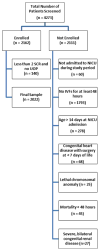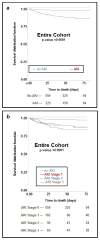Incidence and outcomes of neonatal acute kidney injury (AWAKEN): a multicentre, multinational, observational cohort study
- PMID: 29732396
- PMCID: PMC5933049
- DOI: 10.1016/S2352-4642(17)30069-X
Incidence and outcomes of neonatal acute kidney injury (AWAKEN): a multicentre, multinational, observational cohort study
Abstract
Background: Single-center studies suggest that neonatal acute kidney injury (AKI) is associated with poor outcomes. However, inferences regarding the association between AKI, mortality, and hospital length of stay are limited due to the small sample size of those studies. In order to determine whether neonatal AKI is independently associated with increased mortality and longer hospital stay, we analyzed the Assessment of Worldwide Acute Kidney Epidemiology in Neonates (AWAKEN) database.
Methods: All neonates admitted to 24 participating neonatal intensive care units from four countries (Australia, Canada, India, United States) between January 1 and March 31, 2014, were screened. Of 4273 neonates screened, 2022 (47·3%) met study criteria. Exclusion criteria included: no intravenous fluids ≥48 hours, admission ≥14 days of life, congenital heart disease requiring surgical repair at <7 days of life, lethal chromosomal anomaly, death within 48 hours, inability to determine AKI status or severe congenital kidney abnormalities. AKI was defined using a standardized definition -i.e., serum creatinine rise of ≥0.3 mg/dL (26.5 mcmol/L) or ≥50% from previous lowest value, and/or if urine output was <1 mL/kg/h on postnatal days 2 to 7.
Findings: Incidence of AKI was 605/2022 (29·9%). Rates varied by gestational age groups (i.e., ≥22 to <29 weeks =47·9%; ≥29 to <36 weeks =18·3%; and ≥36 weeks =36·7%). Even after adjusting for multiple potential confounding factors, infants with AKI had higher mortality compared to those without AKI [(59/605 (9·7%) vs. 20/1417 (1·4%); p< 0.001; adjusted OR=4·6 (95% CI=2·5-8·3); p=<0·0001], and longer hospital stay [adjusted parameter estimate 8·8 days (95% CI=6·1-11·5); p<0·0001].
Interpretation: Neonatal AKI is a common and independent risk factor for mortality and longer hospital stay. These data suggest that neonates may be impacted by AKI in a manner similar to pediatric and adult patients.
Funding: US National Institutes of Health, University of Alabama at Birmingham, Cincinnati Children's, University of New Mexico.
Conflict of interest statement
Conflict of interest disclosures All authors declare no real or perceived conflicts of interest that could affect the study design, collection, analysis and interpretation of data, writing of the report, or the decision to submit for publication. For full disclosure, we provide here an additional list of other author’s commitments and funding sources that are not directly related to this study: David J Askenazi serves on the speaker board for Baxter (Baxter, USA), and the Acute Kidney Injury (AKI) Foundation (Cincinnati, OH, USA); he also receives grant funding for studies not related to this manuscript from National Institutes of Health — National Institutes of Diabetes and Digestive and Kidney Diseases (NIH-NIDDK, R01 DK103608 and NIH-FDA (R01 FD005092). Jennifer G Jetton is supported by the University of Iowa Institute for Clinical and Translational Sciences NIH U54TR001356. Juan C. Kupferman is on the speaker’s Bureau and consultant for Alexion Pharmaceuticals. Robert Woroniecki is supported by the Department of Pediatrics at Stony Brook Children’s hospital (NY, USA). AWAKEN investigators at the Canberra Hospital were supported by the Canberra Hospital Private Practice fund, and investigators at University of Virginia Children’s Hospital were supported by a 100 Women Who Care Grant (100 Women Charitable Foundation, CA, USA).
Figures



References
-
- Taylor M, Carmona F, Thiaqarajan RR, et al. Mild postoperative acute kidney injury and outcomes after surgery for congenital heart disease. J Thorac Cardiovasc Surg. 2013;146(1):146–152. - PubMed
-
- Blinder JJ, Goldstein SL, Lee VV, et al. Congenital heart surgery in infants: effects of acute kidney injury on outcomes. J Thorac Cardiovasc Surg. 2012;143(2):368–374. - PubMed
-
- Wong JH, Selewski DT, Yu S, et al. Sever acute kidney injury following stage 1 Norwood palliation: effect on outcomes and risk of sever acute kidney injury at subsequent surgical states. Pediatr Crit Care Med. 2016;17(7):615–623. - PubMed
-
- Di Nardo M, Ficarella A, Ricci Z, et al. Impact of severe sepsis on serum and urinary biomarkers of acute kidney injury in critically ill children: an observational study. Blood Purif. 2013;35(1–3):172–176. - PubMed
-
- Mathur NB, Agarwal HS, Maria A. Acute renal failure in neonatal sepsis. Indian J Pediatr. 2006;73(6):499–502. - PubMed
Grants and funding
LinkOut - more resources
Full Text Sources
Other Literature Sources
Medical
Miscellaneous
